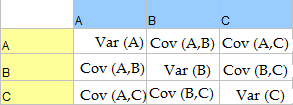Multivariate distributions show comparisons between two or more measurements and the relationships among them. For each univariate distribution with one random variable, there is a more general multivariate distribution. For example, the normal distribution is univariate and its more general counterpart is the multivariate normal distribution. While the multivariate normal model is the most commonly used model for analyzing multivariate data [1], there are many more: the multivariate lognormal distribution, the multivariate binomial distribution, and so on.
A bivariate distribution is the simplest multivariate distribution, comprised of one pair of random variables. However, theoretically at least, you could have an infinite number of pairs; all results from a bivariate distribution for two pairs can be generalized to n random variables.
Joint Probabilities and Multivariate Distributions
Each random variable in a multivariate distribution has its own mean and variance: there isn’t a “one size fits all” probability density function, like you would find with a univariate distribution. For discrete random variables, multivariate distribution and described by joint probabilities. For continuous random variables, the relevant univariate distribution is extended. However, once you dive into the depths of multivariate distributions analysis gets a little more complicated. As multivariate analysis involves vector observations, an understanding of the variance-covariance matrix is “vital” to understanding multivariate normal distributions [2].

Multinomial vs. Multivariate Distribution
The multinomial and multivariate distributions share many similarities, but there is one important difference: a multinomial distribution has a dependent variable with more than one outcome (i.e., the dependent variable has two or more levels), while a multivariate distribution has more than one dependent variable.
References
[1] Engineering Statistics Handbook. The Multivariate Normal Distribution. Retrieved November 11, 2021 from: https://www.itl.nist.gov/div898/handbook/pmc/section5/pmc542.htm
[2] Do, C. (2008). The Multivariate Gaussian Distribution.